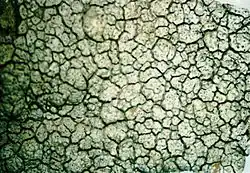Aspicilia cinerea
| Aspicilia cinerea | |
|---|---|

| |
| Aspicilia cinerea | |
| Scientific classification | |
| Kingdom: | Fungi |
| Division: | Ascomycota |
| Class: | Lecanoromycetes |
| Order: | Pertusariales |
| Family: | Megasporaceae |
| Genus: | Aspicilia |
| Species: | A. cinerea
|
| Binomial name | |
| Aspicilia cinerea | |
| Synonyms | |
| |
Aspicilia cinerea (cinder lichen) is a gray to almost white, 1.5–15 cm (0.59–5.91 in) wide, crustose areolate lichen with large apothecia that mostly grows on rock in the mountains.[2][3]: 224 It grows in variable forms, from having a continuous surface to being areolate.[3]: 224 It grows in Eurasia, and North America on siliceous rock, schist or igneous rock in habitats exposed to sunlight, also rarely on calciferous rock.[2] It is common in Arizona, and rare in California and Baja California at elevations of 1,700 to 3,300 metres (5,600 to 10,800 ft).[2]
Flat to almost convex areoles are angular to irregular, and 0.2–2 mm in diameter.[2] They are contiguous but clearly separated by well defined cracks.[2] It usually lacks a prothallus.[2] It may be rimose toward the outer edges.[2] Each areole has 1–10, round to angular or irregular, 0.1–1.6 mm apothecia that may be confluent when numerous.[2] Apothecia have usually black concave discs, with exciple margins of thallus tissue.[2] Asci are club shaped (clavate), with 8 ellipsoid ascospores.[2]
Lichen spot tests on the cortex and medulla are K+ red, KC−, P+ yellow[3]: 224 or P+ orange,[2] with the medulla sometimes testing K+ yellow and P+ orange.[3]: 224 Secondary metabolites include norstictic acid and often connorstictic acid in traces, and more rarely hyposalazinic acid.[2]
The photobiont is a chlorococcoid.[2]
References
- ^ NatureServe. "Aspicilia cinerea". NatureServe Explorer. Arlington, Virginia. Retrieved 13 July 2025.
- ^ a b c d e f g h i j k l m Lichen Flora of the Greater Sonoran Desert Region. Vol 3., Nash, T.H., Ryan, B.D., Gries, C., Bugartz, F., (eds.) 2001, [1]
- ^ a b c d Field Guide to California Lichens, Stephen Sharnoff, Yale University Press, 2014, ISBN 978-0-300-19500-2
